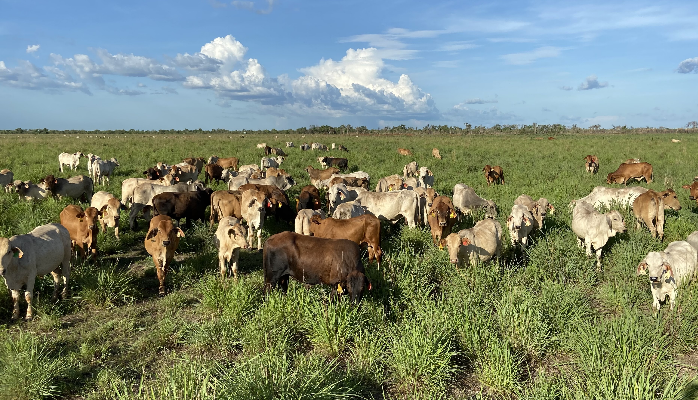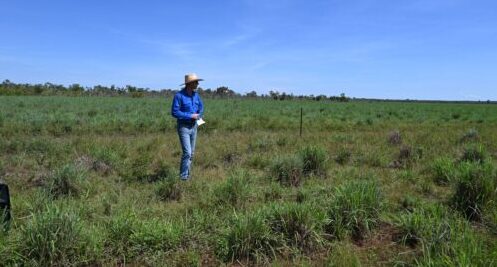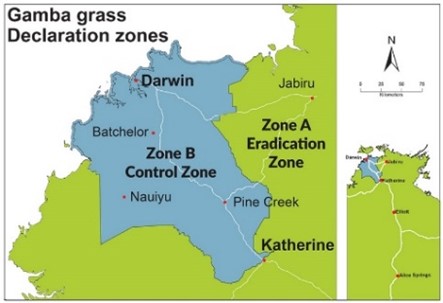Gamba grass grazing trial at Douglas Daly Research Farm – 2019-2023
Key messages:
- Gamba grass is a declared weed and must be controlled.
- When tall and rank, Gamba has little value for grazing and is a fire hazard.
- Rotational grazing can keep Gamba short and palatable, while stopping it from producing seeds and spreading.
- Paddocks already infested with Gamba which were once unproductive can be rotationally grazed with good weight gain results, and the Gamba seeding and spread is controlled at the same time.
Prefer to listen? Click here
Background
Gamba grass (Andropogon gayanus) is a perennial tussock grass that was introduced to Australia as an improved pasture species but is now listed as a Weed of National Significance and is spreading throughout northern Australia. It grows rapidly during the wet season and when ungrazed or grazed with set-stocking becomes tall and unpalatable to cattle and other herbivores. As a result other grasses get grazed selectively, creating an environment that can cause gamba grass to dominate and spread.
Gamba grass grows into large tussocks (up to 4 m tall) and the high biomass (up to >20t/ha) compared to native species (<6t/ha) significantly increases fuel load for fires. It also matures later in the dry season compared to most native species. These changes in timing and quantity of fuel load can result in significantly hotter wildfires than those fuelled by native grass species. As a result, long-term environmental impacts through habitat change are likely to occur. Intense Gamba grass fuelled wildfires are also a significant danger to livestock, native animals, people, buildings and property.

Gamba grass has already spread through large areas on the northern NT (estimated 10-15,000 km2) including many areas that are difficult to access, making eradication unlikely, and control using chemicals difficult and expensive. Therefore, better ways to manage Gamba grass are required.
Also, while unmanaged Gamba grass is a problem, many cattle graziers view it as a valuable pasture. When Gamba grass is grazed with traditional methods (eg. set stocking) it grows so rapidly that it quickly becomes tall and unpalatable, with subsequent growth rates of cattle grazing it have been poor. However, anecdotal reports and this trial, are showing that intensive rotational grazing results in better livestock productivity and controls growth, seed production, spread, and reduces fire hazard; delivering a “win/win” control option for graziers and the environment.
The trial
The Gamba grass rotational grazing trial at Douglas Daly Research Farm (DDRF) began in late 2018. The aim was to investigate how to use rotational grazing to control Gamba grass whilst achieving good animal production outcomes — keeping the weedy grass short so that it doesn’t become a fire hazard, or seed prolifically and spread.
Keeping it short also keeps it palatable and nutritious for cattle and so should increase the cattle production through the wet season infested paddocks. Some commercial cattle producers have rotationally grazed Gamba grass previously, but there does not seem to be any publicly available objective data on cattle performance. This trial aims to provide this information.
An area of 180 ha at DDRF that has been infested with Gamba grass is being used for this trial. Historically, this area used to be one of the worst on the property for cattle production due to the tall, rank tussocks of the weed that dominated the area.
In 2018 it was subdivided into 5 smaller paddocks (20-38 ha) to enable rotational grazing. A mob of 360 cattle rotationally graze the 5 paddocks with the aim of keeping the grass short and palatable, and then giving it time to recover before grazing it again.
The overall stocking rate over the trial area of 180 ha is 2 head per ha. However, when the mob of cattle was in one of the small paddocks the grazing density in the paddock at that time ranged from 9.5 to 18.5 head per ha depending on the size of the paddock. The mob of cattle stays in a paddock for between 2 and 6 days depending on how quickly the grass height is reduced. The aim has been keep the grass in all paddocks below knee height.
Results
The average daily gain (ADG) of cattle grazing in the infested area over a number of years are shown in Table 1. In most years the growth was recorded from mid-December to early April. Whilst these ADGs are not as high as you would see on improved pastures, they are significantly higher than what was possible from this area when the Gamba was tall and rank.
Table 1. Average daily gains (ADG) of cattle grazing Gamba in the trial
| Wet seasion | Yearling bull ADG (kg/day) | 2 year old steer ADG (kg/day) |
|---|---|---|
| 2018/2019 | 0.58 | 0.71 |
| 2020/2021 | 0.53 | 0.52 |
| 2021/2022* | 0.86 | 0.74 |
| 2022/2023 | 0.56 | 0.43 |
| Aaverage | 0.63 | 0.6 |
In each year since the start of the trial the Gamba grass has been kept short by grazing and has not produced any seeds. Essentially, the use of rotational grazing has been a successful method of control for Gamba grass.
Summary
The trial is demonstrating a win-win strategy that controls Gamba grass (limits its growth and spread) and increases the growth rates of cattle grazing infested country.

Gamba grass management responsibilities
Gamba grass is a declared weed throughout the Northern Territory under section 7 of the Act. This prohibits movement or transport of the weed on a public road by itself or as a contaminant, its entry to the NT, or sale by itself or as a contaminant. Land owners and occupiers in Zone A (all areas of the NT except Zone B) are required to eradicate Gamba grass. Land owners and occupiers in Zone B (see picture below) are required to control the growth and spread of Gamba grass. The intensive rotational grazing management described in this article is being investigated as a method of controlling the growth and spread of Gamba grass. Find out more information about Gamba grass management responsibilities here.

This work has been funded by the Northern Territory Department of Industry, Tourism and Trade.
